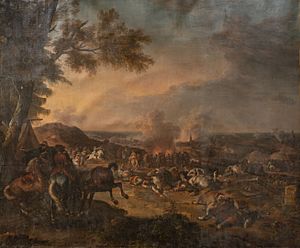Battle of Nördlingen (1645) facts for kids
Quick facts for kids Battle of Nördlingen |
|||||||
|---|---|---|---|---|---|---|---|
| Part of Thirty Years' War | |||||||
 The Battle of Nördlingen by Jean-Baptiste Le Paon |
|||||||
|
|||||||
| Belligerents | |||||||
| Commanders and leaders | |||||||
| Strength | |||||||
|
17,000 men
|
16,000 men
|
||||||
| Casualties and losses | |||||||
| 4,000 |
4,000
|
||||||
The second Battle of Nördlingen (also known as the Battle of Allerheim) was a major fight on August 3, 1645. It happened near the village of Alerheim in what is now Germany. In this battle, the armies of France and their Protestant German allies won against the forces of the Holy Roman Empire and their Bavarian friends. This battle was part of the long and difficult Thirty Years' War.
Contents
Why the Battle Happened
Setting the Stage for Conflict
The Holy Roman Empire and its main German ally, Bavaria, were facing tough times in the Thirty Years' War. They were under a lot of pressure from France, Sweden, and their Protestant allies. They really wanted to stop the French army from moving deeper into Bavaria.
The Battlefield: Alerheim
The Imperial-Bavarian army had about 16,000 soldiers. Their leaders were Field Marshal Franz von Mercy and Johann von Werth. They set up their defenses on high ground near the village of Alerheim, about 10 kilometers southeast of Nördlingen.
- Their right side was on a hill called Wennenberg.
- Their left side was on another hill with a castle, the Schloss Alerheim.
- The middle of their army was on a lower ridge between these two hills.
- To make their middle stronger, they put some soldiers in the village itself, blocking it off.
- They hoped the French would have to attack uphill, right into their cannons, which would be a big disadvantage for the French.
The Battle Unfolds
Joining Forces for France
Before the battle, two French armies joined together. Marshal Henri, Vicomte de Turenne, brought his Franco-German army. The Duc d'Enghien (who later became Prince de Condé) led an all-French army. About 6,000 Hessian soldiers, led by Johann von Geyso, also joined them.
The combined army had about 17,000 soldiers and was led by Enghien. His plan was simple: he wanted the French troops to charge straight at the Imperial positions. It took the French army from noon until 4:00 PM to get their battle lines ready.
Fierce Fighting and Key Moments
The Imperial army didn't wait; they attacked almost right away. Soldiers charged downhill from Schloss Alerheim. They broke through Enghien's right side, which was not ready. This forced Enghien to stop his attack on the Imperial center.
On the other side of the battlefield, Turenne fought hard at the Wennenberg hill. When the Wennenberg fell, the Imperial right side pulled back. Their left side moved forward, so the Imperial army ended up facing a different direction. During this intense fighting, Field Marshal Mercy was killed.
By evening, both armies were still on the field. But in the darkness and confusion, the Imperial soldiers in the village thought they were surrounded. They gave up. Later that night, the Imperial army accepted defeat and left the battlefield, heading to Donauwörth.
What Happened After
Losses and Gains
The French and German armies lost about 4,000 soldiers. This included those killed, wounded, and captured. Marshal Gramont was captured, and three colonels died. They also lost 70 flags. The Bavarian-Imperial army had similar losses. About 2,500 were killed or wounded, and 1,500 were captured. They also lost 12 cannons.
After their victory, the French were able to capture the cities of Nördlingen and Dinkelsbühl. However, Enghien became sick while trying to capture Heilbronn. Turenne was left in charge. He had to stop the siege because a larger Imperial-Bavarian army, led by Archduke Leopold Wilhelm, arrived with more soldiers from Bohemia. Turenne eventually had to retreat to Philippsburg.
The Overall Impact
So, the only real gains for France from this very bloody victory were taking Nördlingen and Dinkelsbühl. Bavaria was safe for a little while. The battle gave the French a short break, but it didn't stop Bavaria from being invaded again the next year.
In 2008, archaeologists found a mass grave of 50 skeletons, likely French soldiers, just outside the town of Alerheim.

